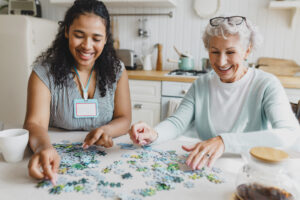One of the great things about San Francisco is its history—a once rough harbor joint; an international, smoky city full of sailors and dreamers from around the world. It seemed built for mystery: between the colorful characters and smothering fog, it’s no accident that it’s the birthplace of noir. All that history, throughout San Francisco and the greater Bay Area, means there are still quite a few older houses and residences, with unique histories of their own. If walls could talk…
Unfortunately, intriguing histories aren’t all these buildings are known for. They can also house safety concerns for older residents, barriers to aging in place, for San Franciscans who might remember the Bay before the rise of Silicon Valley. And while these houses are undeniably beautiful, the dangers they present must be addressed if your loved one is planning to grow older along with their home, with independence and dignity.
Home Safety Tips for San Francisco’s Historic Neighborhoods
Luckily, with some adjustments and a little caution and care, your aging loved one can still safely call their San Francisco historic neighborhood home for years or decades to come. You can take the role of helping them guard against both common and rarely thought of issues, so your older loved one can continue to fill the walls of their older Bay Area home with stories of their own. No need for the walls to talk.
There is one contradiction to be aware of when considering how your loved one can safely age in place: preventing falls without exacerbating other issues. Oftentimes, what can be good for one isn’t ideal for the other, so it’s about finding a balance. There are, of course, other factors at play as well, which vary depending on the older adult, but those are the two primary concerns. We’ll see how important they are as we start by discussing floors below.
Flooring for Older Adults: Balancing Comfort, Safety, and Cleanliness
Many older homes in San Francisco and the Bay Area have beautiful hardwoods. While gorgeous, they can also be very slippery. That’s a problem for anyone who might have trouble with balance (especially if they are taking antihypertensive blood pressure medication). Of course, balance-improving exercises like walking, swimming, and yoga are always encouraged, but it’s also recommended to remove dangerous flooring altogether. But how should you safely replace it? Here are four important considerations:
- Relative softness: We don’t mean installing a floor that reminds you of a waterbed, but harder elements like stone, brick, or ceramic are hard on the joints and, more seriously, can be very damaging in case of a fall.
- Respiratory issues: Floors can get extremely dirty, and promote bacteria and mold growth. This is especially true of carpets, which are very soft but also trap dust and spores that get kicked back up with every step.
- Ease of cleaning: Older adults might have more trouble regularly cleaning their floor, so you want to choose an option that’s easy to clean and doesn’t require a lot of maintenance. Stone is bad on both counts, and cork floors, while soft, can be damaged easily.
- Cost: This is always important for seniors on fixed incomes, or whose loved ones are sacrificing income to help them age in place. Rubber floors are soft and relatively easy to maintain, as well as incredibly safe for seniors (creating wall-to-wall padding, essentially), but can be as much as $15 a square foot, pricing out most people.
So, choosing the right floor, whether it’s one listed above or linoleum, or even keeping the hardwood and adding no-slip strips, depends on the needs of your loved one and your economic realities. It’s up to you, and possibly a medical professional, to find that right balance.
Do the Light Thing: The Importance of Lighting for Aging in Place
You can’t really overestimate the importance of proper lighting in the homes of older adults. Here are a few tips to make sure there’s enough light to avoid crashes, falls, or strains:
- Have consistent lighting: We all know what it’s like to move from a well-lit room to a dark one, or vice-versa. It takes a few seconds to adjust. When your eyes are weaker, this adjustment period is longer, and susceptibility to even lesser contrast is heightened. Have lights of consistent brightness throughout the house to avoid these strains.
- More ambient lighting: Older adults are more prone to glare, and to their eyes hurting if lights are too bright. Make sure all light fixtures are covered.
- Encourage natural light: I know it’s often rainy and gloomy in San Francisco, but not always, and a lot of the Bay Area gets a ton of natural light. Remove heavy shades and, if possible, install more windows and skylights. Natural light is usually softer—and more cheerful as well.
- Use table or floor lamps: Sitting areas, where your loved one might read or work, should be well-lit enough so they don’t have to strain their eyes while engaging in these activities. Lamps provide more light than overhead options.
- Keep switches at room entrances: You don’t want your aging loved one to have to cross an entire room to find the light switch. If at all possible, use wall switches as the primary light source in every room.
- Light a path to the bathroom: For older adults who get up in the night to use the bathroom, install track lighting down the hallway and leave a dim light on in the bathroom. When you just wake up, you’re more groggy, and more prone to falling or tripping over something. That little bit of light can make all the difference.
Living in an older home means being surrounded by a bit of Bay Area history every day. Whether it’s a noirish residence in San Francisco or a home imbued with the romantic glory of an old boomtown residence, now in a new boom, historic homes are a fascinating square in the quilt of our city. But, they also expose potential safety issues for older adults, which, with a little foresight can thankfully be fixed fairly easily.
Updating an older home for your aging loved one doesn’t have to mean you’re flipping a whole house. But it may mean you’re preserving a life. You’re helping your older loved one age in place, in a home they can call their own. It means writing even more stories for the walls to tell in the years to come.
Institute on Aging offers a wide range of programs and services that help older adults age in place, with a spirit of independence and adventure. Get in touch with us today to learn more.







